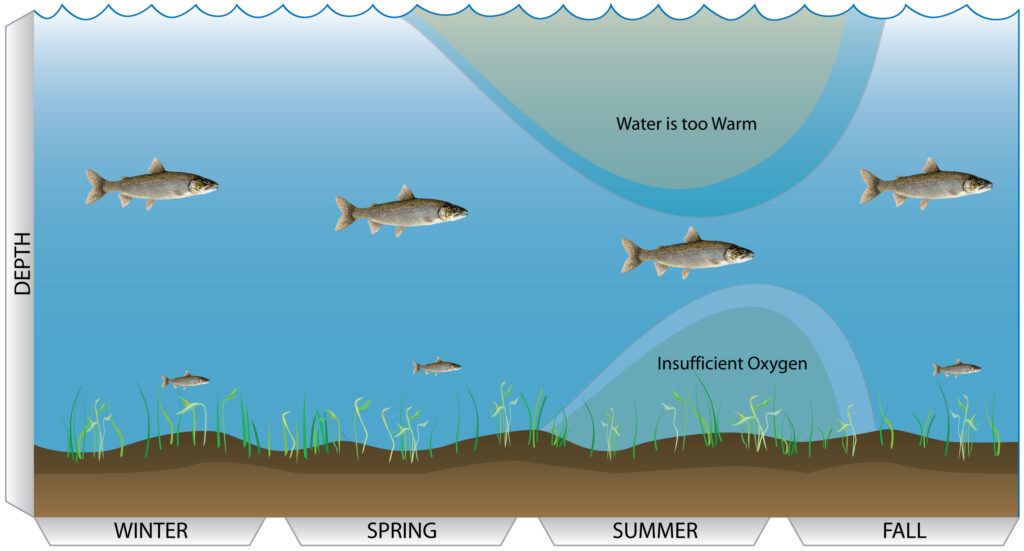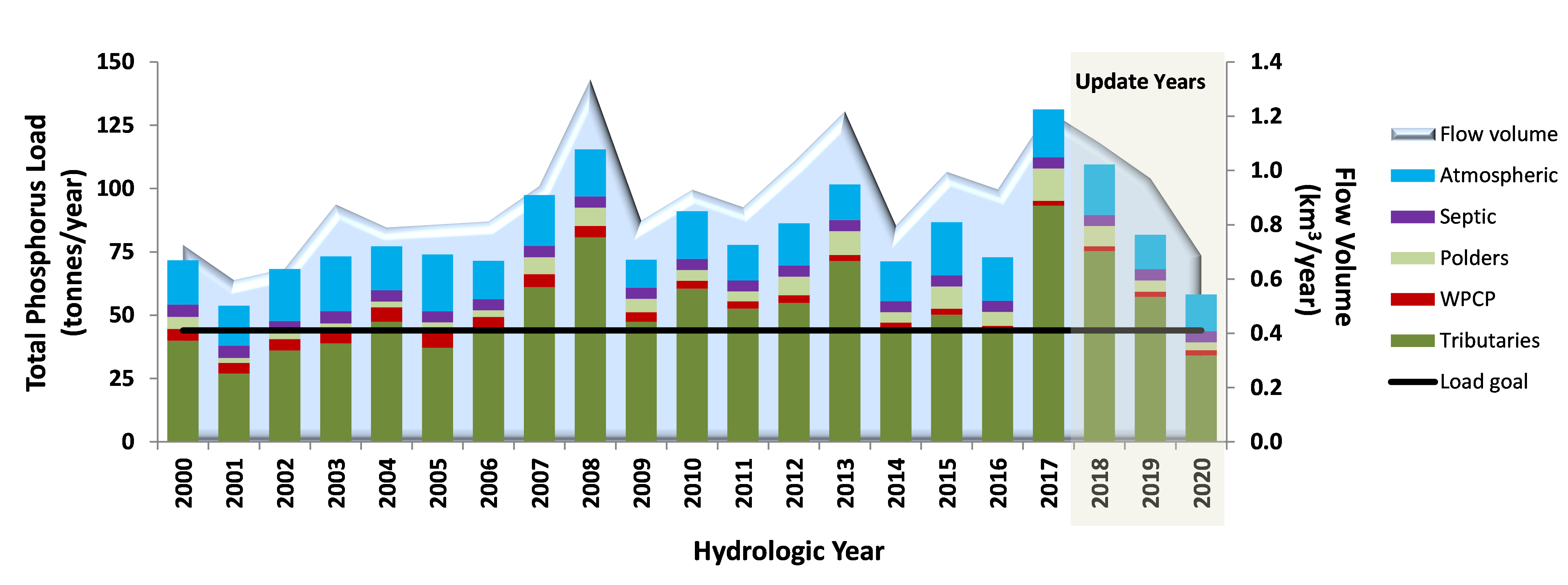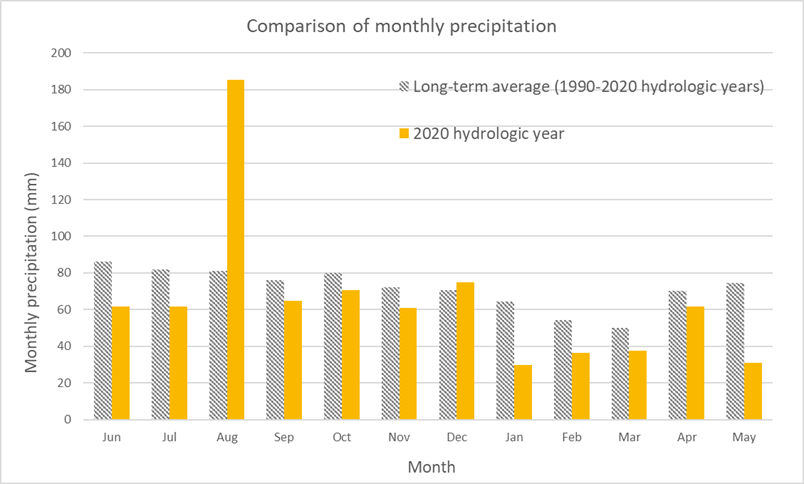Phosphorus Loads Update 2018-2020
Long term monitoring is a critical part of the overall effort to restore the health of Lake Simcoe. Monitoring is needed to measure the success of phosphorus reduction actions, as well as progress towards achieving the Lake Simcoe Protection Plan target of 7 mg/L for dissolved oxygen (Lake Simcoe protection plan | Ontario.ca).
Phosphorus loads have been monitored since the 1990s to track the total amount of phosphorus entering Lake Simcoe from all sources. Annual phosphorus loads are one of several parameters that are used to assess the health of the lake and how it’s changing over time. This report provides an update on the three most recently calculated hydrologic years of 2018 to 2020.
Phosphorus Loads and Lake Dissolved Oxygen Concentration
Phosphorus is necessary in water bodies such as lakes, but too much can cause serious issues including excessive plant and algae growth. Not only can excessive plant and algae growth become a nuisance and detract from recreational opportunities, but as plants and algae die and decompose they consume the oxygen in deep water that cold-water fish species like Lake Trout and Lake Whitefish need to survive.
At its heart, the Lake Simcoe Protection Plan is focused on restoring a healthy and sustainable cold-water fish community in Lake Simcoe. To help achieve that goal, a target for end of summer, deepwater dissolved oxygen concentration of 7 mg/L was set. There is a relationship between phosphorus loads and dissolved oxygen in a lake. Decomposing plants and algae use up dissolved oxygen, and the amount of algae present in the lake is controlled, to some extent, by in-lake phosphorus levels. These phosphorus levels are in-turn controlled by phosphorus loading. In this way, the target 7 mg/L of dissolved oxygen is linked to an ideal phosphorus loading goal of 44 tonnes per year (Lake Simcoe protection plan | Ontario.ca).
Based on modelling when the Lake Simcoe Protection Plan was being developed, this phosphorus loading goal was estimated to keep in-lake phosphorus levels low enough to provide optimal dissolved oxygen for cold-water fish at the end of summer. However, we are now seeing other emerging issues such as climate and invasive species, as described below, that are impacting how phosphorus is being used in Lake Simcoe.

Phosphorus Load Update (2018 to 2020)
This report provides phosphorus loads for the period of June 1, 2018 to May 31, 2021, which is three hydrologic years. A hydrologic year is from June 1 of one year to May 31 of the next year. The phosphorus load for these hydrologic years is 110 tonnes in 2018, 82 tonnes in 2019 and 58 tonnes in 2020. Phosphorus loads by source from 2000 to 2020 are shown below. Also shown is the annual tributary flow volume, which is the amount of water transported to the lake via all the watershed rivers and streams. Wet years with high tributary flows tend to see high phosphorus loads while dry years with lower tributary flows tend to see lower phosphorus loads.
The tributaries are the largest source of phosphorus loads to Lake Simcoe. On average they contributed 62% of the total load each year for the 2000 to 2020 period. Tributary loads are affected by climatic conditions, including the amount and timing of precipitation each year. Wet weather conditions can cause high flow events in the tributaries that carry large amounts of phosphorus to the lake. Greater flow amounts and higher phosphorus concentrations lead to a higher load from the tributaries to Lake Simcoe. On the other hand, drier weather conditions are associated with lower flows and phosphorus loads. As tributaries contribute the largest portion of the loads to Lake Simcoe, variation in the total annual load can be generally attributed to variation in the tributary loads.
Since 2000, there have been several high load years including 2008, 2013, 2017 and 2018. Past phosphorus load reports discussed the climatic conditions that led to greater tributary flows and resulting higher loads in those years. The 2018 hydrologic year, which is in this reporting period, also recorded more precipitation than a typical year for most months of that year. For example, there were six intense rain events in July and August, with each seeing between 20 and 45mm. While the loads from each single event were not abnormal, it was the combination of all these storm events that led to a higher load year.
2020 a low load year
The 2020 hydrologic year saw one of the lowest phosphorus loads in the last two decades at 58 tonnes. Overall, it was a relatively dry year with total monthly precipitation being below the long-term average for ten months of that year. The largest deviation occurred in August, which had a single day rain event of ~80mm on August 2. However, dry conditions preceding the event meant much of the rainfall was absorbed into the ground and by vegetation, leaving relatively little to runoff into tributaries.
As a result, the event did not produce significant tributary flows or loads; the total load being only 0.5 tonnes for the event. By contrast, falling on already saturated ground, a 38mm event June 22 through 23 in 2017 resulted in significant flows in tributaries and a load of 13 tonnes of phosphorus in two days alone. Overall, in 2020, dryer conditions resulted in less water flowing through the tributaries, and less phosphorus being carried to Lake Simcoe, therefore resulting in a lower phosphorus load.
Understanding the health of Lake Simcoe
Phosphorus loads are one measure of the health status of Lake Simcoe. Lakes are complex systems with physical, chemical, and biological factors interacting with each other, and with the surrounding environment. For this reason, we rely on many other parameters to determine the environmental status of Lake Simcoe. Alongside chemical parameters, such as phosphorus, are important physical parameters such as water temperature and biologic parameters, such as aquatic plants.
Phosphorus is an important parameter because of the traditional link phosphorus loads have with dissolved oxygen levels. As previously explained, phosphorus levels impact oxygen levels in the lake. Essentially, higher phosphorus loads lead to higher in-lake phosphorus, which lead to less dissolved oxygen.
In more recent years, we are seeing a change in the relationship between phosphorus loads and dissolved oxygen. Deepwater dissolved oxygen has improved in the long term despite some years with high phosphorus loads (e.g., 2008). Targeted studies are being undertaken to understand the role of climate, invasive species, and other biological changes that may be influencing the relationship between phosphorus loads and dissolved oxygen. These studies may inform the Lake Simcoe Protection Plan adaptive management approach by providing new information about the effect of emerging issues on the total phosphorus loads needed to achieve and sustain dissolved oxygen of 7 mg/L.
The interactions of climate change, invasive species, and biological changes in Lake Simcoe have changed how phosphorus is being used in the lake, and how the lake responds to changing phosphorus loads. By investigating and improving our understanding of these new interactions in Lake Simcoe, we will be able to better manage it, making it a healthier and more sustainable ecosystem for generations to come.
Moving forward
A healthy Lake Simcoe, now and into the future, requires continued work and ongoing monitoring throughout the watershed. The Conservation Authority and watershed partners are continuing to work on programs, such as our Lake Simcoe Phosphorus Offsetting Program, which aims to achieve zero net phosphorus for all new large development in the watershed. The offsetting program implements a strategic direction in the Phosphorus Reduction Strategy for Lake Simcoe. We’re working with municipalities to retrofit stormwater ponds and to introduce Low Impact Development technologies to manage stormwater. Our tree planting programs also serve to help reduce phosphorus by preventing soil erosion. In addition, we continue to research new and innovative technologies aimed at reducing phosphorus loading.
Residents can help contribute to lower phosphorus levels in the lake by taking individual actions on their properties. Every little bit helps. Check out our funding and expertise page to find opportunities to help restore the watershed and save money.
Highlights
- This report provides phosphorus loads for the period of June 1, 2018 to May 31, 2021, three consecutive hydrologic years. The hydrologic year runs from June 1 to May 31 of each year.
- The calculated loads for 2018 to 2020 hydrologic years:
- 2018 = 110 tonnes
- 2019 = 82 tonnes
- 2020 = 58 tonnes
- The three-year average of 83 tonnes for the most recent period (2018-2020 hydrologic years) is lower than the five- or ten -year averages of 91 and 88 tonnes, respectively. This was driven by the low load of 2020.
- Ten months of the 2020 hydrologic year had below average precipitation. Despite this, annual precipitation in 2020 was only 10% lower than the long-term annual average. This is because August was a very wet month and contributed one quarter of rain for the whole year.
- Not all rain events trigger a significant phosphorus load. Response in the tributaries to the precipitation event in August of 2020 (~80 mm of rain on August 2) was minimal due to preceding dry conditions and full vegetative cover, which enabled the water to be absorbed into the ground rather than running-off into the tributaries.
- Climate change will affect the timing and amount of phosphorus coming from tributaries. With more snow-melt events in winter and intense rain events in summer, there are increased flows and loads already being observed in these seasons. These types of conditions are predicted to increase in frequency with climate change.


